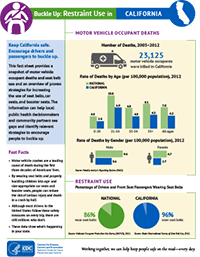What Works: Strategies to Increase Car Seat and Booster Seat Use
The strategies in this section are effective for increasing car seat and booster seat use. They are recommended by The Guide to Community Preventive Services and/or have been demonstrated to be effective in reviews by the National Highway Traffic Safety Administration.* Different strategies may require different resources for implementation or have different levels of impact. Find strategies that are right for your state.
See What Works: Strategies to Increase Restraint Use for strategies for increasing seat belt use.
Strategies to increase car seat and booster seat use
Child restraint laws
Child restraint laws require children riding in a car to use approved restraint devices (car seats, booster seats, or seat belts) appropriate for their age, height, and weight. Strengthening current laws with booster seat provisions helps reduce injuries and deaths by requiring children who have outgrown car seats to use booster seats through age 8 years or until seat belts fit properly.
Enhanced enforcement
Enhanced enforcement programs for child passenger safety are similar to those used for seat belt use (see above). Effective programs are short-term, highly visible in the community, and advertised widely in the media.
Distribution plus education programs
Distribution plus education programs help parents and caregivers get access to car seats through giveaways, loans, or low-cost rentals. They also teach the importance of car seats and how to properly use and install them.
Incentive and education programs
Incentive and education programs reward parents or children with coupons or other prizes for correctly using car seats. Programs offer print materials, videos, or other instructional aids for parents and caregivers.
*Sources
The Guide to Community Preventive Services (The Community Guide), Motor Vehicle-Related Injury Prevention, at www.thecommunityguide.org, and National Highway Traffic Safety Administration. (2013). Countermeasures that work: a highway safety countermeasures guide for State Highway Safety Offices, 7th edition, at www.nhtsa.gov/staticfiles/nti/pdf/811727.pdf.
State Fact Sheets and Data

Working together, we can help keep people safe on the road – every day. Encourage drivers and passengers to buckle up on every trip.
Fact sheets are available for each state and the District of Columbia and include national and state data on restraint use and occupant crash deaths, as well as an overview of proven strategies for increasing the use of seat belts, car seats, and booster seats.
Need data for your state? View and download seat belt datasets from our State Data web page.
Related Pages
- Buckle Up: Restraint Use State Fact Sheets
- Restraint Use and Motor Vehicle Occupant State Data
- Seat Belts: Get the Facts
- Seat Belt Use US Map
- Child Passenger Safety
- State-Based Motor Vehicle Data & Information
-
data.cdc.gov
View and download dozens of motor vehicle datasets and visualizations, including charts and maps, on data.cdc.gov.
-
Motor Vehicle Prioritizing Interventions and Cost Calculator for States (MV PICCS)
CDC offers a new interactive calculator to help state decision makers prioritize and select from a suite of 14 effective motor vehicle injury prevention interventions. MV PICCS is designed to calculate the expected number of injuries prevented and lives saved at the state level and the costs of implementation, while taking into account available resources.
-
CDC's Safe Driving Board on Pinterest
Help spread the word about the dangers of drunk driving. Visit the CDC Safe Driving Pinterest board for ready-to-share graphics and social media content.
- Page last reviewed: January 21, 2015
- Page last updated: January 21, 2015
- Content source:
- Centers for Disease Control and Prevention,
- National Center for Injury Prevention and Control,
- Division of Unintentional Injury Prevention


 ShareCompartir
ShareCompartir
